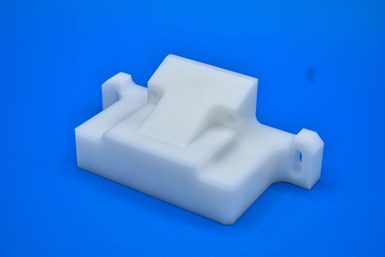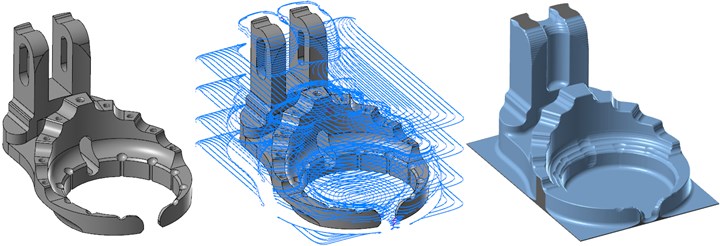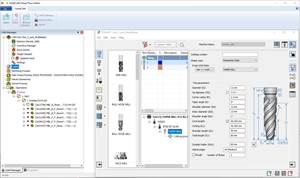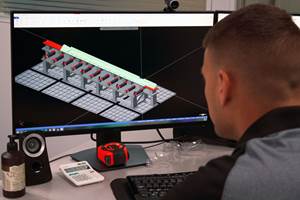In Plastics Machining, One Sharp Tool Does It All
Milling plastic can pose a variety of challenges, but keep a few principles in mind and quality parts will follow.
With a business model sketched out on a napkin at the start of 2017, Greg and Shelly McArthur dedicated their home garage to a new business venture: a CNC machine shop. NTL Industries Inc. would be Greg’s opportunity to take everything he had learned in his 20 years of CNC machining experience and make a go at running his own business from the ground up.
After a year in the garage shop, the shop had the opportunity to upgrade to a larger space in Sterling Heights, Michigan. The move to the new facility was built on a culture of saying “yes” to as many RFQs as possible.
In some cases, saying “yes” involves working with whatever material the customer specifies, even if it falls outside the norm. One recent example was a small plastic part for the automotive industry. The size and shape of the part didn’t immediately lend itself to a fast cycle time, but McArthur was confident that he could make it a profitable part.

NTL Industries Inc. serves a wide range of industries but is pushing its product development into the motorsport industry. With each new job, the shop is quick to equip itself with machines and tooling that keep it ahead of the competition.Photo Credit: Jeannie Skirpan, NTL Industries Inc.
Plastic machining requires thinking differently than machining other materials, but McArthur has a simple approach: “I treat it like aluminum, but faster.” Asked for more specifics, he cites the following principles as key to plastic milling success:
-
Avoid the Melting Point
McArthur’s “faster” motto mitigates the thermal issues that often plague plastic operations. This is because plastic — in this case, ultra high molecular weight (UHMW) polyethylene — often has significant problems during milling operations. The melting point is around 260°F, and thermal expansion happens rapidly. If the feed rate were too slow, the material could build up around the cutting edge and start to melt back together. These blobs and hanging bits of melted plastic interfere with the cut and lead to even greater heat buildup, compounding the problem. Running without coolant also promotes faster chip evacuation with the plastic material.

The right tool path enabled milling the entire part with a single end mill in three setups and 37 minutes on a 3-axis mill.
Photo Credit: Jeannie Skirpan, NTL Industries Inc.
-
Sharp Tools Are Imperative
When cutting any kind of plastic, a brand-new tool is best. This ensures that the material will not absorb any additional friction as result of a dull cutting edge.
McArthur used a 0.25", 3-flute carbide end mill with a 0.030" corner radius for all operations on this part, from roughing to finishing. The rounded end of the bit enabled chamfering operations without changing the tool. A final cycle time of 37 minutes made this a profitable part for the shop.
- CAM From the Bottom up
McArthur also cites Mastercam’s Optirough tool paths as critical to making this plastic part a profitable part. This strategy improved cutting efficiency by engaging a larger portion of the end mill’s length, thereby avoiding concentrating wear at the tool tip.
The plastic part was a good candidate for Optirough in part because it has features and faces at different heights, McArthur says. Such geometry facilitates aggressive roughing between the features using as much of the tool flute as possible. For this job, McArthur was able to maintain a 1.125" depth of cut with a 10% step over. Reducing passes is a common way that NTL Industries seeks to make their processes more efficient, “How can I create this part with the smallest number of passes to get the shape I need?” McArthur asks.

OptiRough is well suited for tall parts with significant horizontal steps. Deep, optimized cuts with a consistent chip load save machining time and reduce tool wear. Solid verification of the process not only lets the user check the results, but provides a solid model reference for the finish tool paths to work from.
Photo Credit: Mastercam
Related Content
How Integrated CAD/CAM Transforms Inventions Into Products
The close connection between CAD and CAM is what links creative ideas to practical production for this unique custom manufacturer.
Read MoreBuilding A Powerful Bridge from the CAM Programmer to the Shop Floor Operator
SolidCAM for Operators provides a powerful bridge from CAM programming to the shop floor to best streamline the machine shop process with its CAM part simulation. It provides a clear picture to the operator for setup and prove-out, enables minor G-Code changes and avoids crashes, broken tools and scrapped parts.
Read MoreLarge-Format Machining With Small Cutting Tools and Dynamic Motion
Napoleon Machine, a defense contractor that provides parts for the M1 Abrams tank, recently took advantage of a CAM feature that allowed the company to streamline its cutting strategies and program offline. Here’s how the shop cut cycle times nearly in half with its large-format five-axis machining operations.
Read MoreWhen to Use Custom Macros With a CAM System
Custom macros can offer benefits even when using a CAM system to prepare programs – but must be implemented with the right considerations.
Read MoreRead Next
Obscure CNC Features That Can Help (or Hurt) You
You cannot begin to take advantage of an available feature if you do not know it exists. Conversely, you will not know how to avoid CNC features that may be detrimental to your process.
Read More3 Mistakes That Cause CNC Programs to Fail
Despite enhancements to manufacturing technology, there are still issues today that can cause programs to fail. These failures can cause lost time, scrapped parts, damaged machines and even injured operators.
Read MoreThe Cut Scene: The Finer Details of Large-Format Machining
Small details and features can have an outsized impact on large parts, such as Barbco’s collapsible utility drill head.
Read More


























